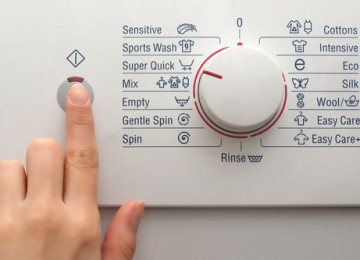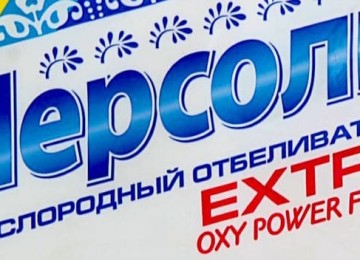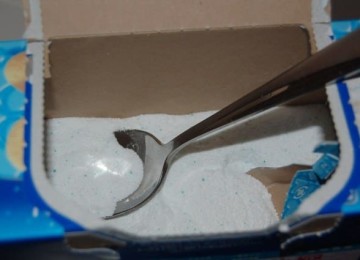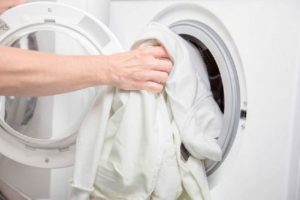 Washing clothes is a mundane and incredibly simple everyday task, but even with the use of a washing machine, many make fatal mistakes that cause white clothes to remain that way forever. This article will provide tips that will help you wash white clothes in an automatic washing machine.
Washing clothes is a mundane and incredibly simple everyday task, but even with the use of a washing machine, many make fatal mistakes that cause white clothes to remain that way forever. This article will provide tips that will help you wash white clothes in an automatic washing machine.
What should you do before washing?
From the very beginning, you will need to sort your laundry by color; you should not wash white laundry with black socks. If there is nothing for the socks, then the underwear will be hopelessly damaged, and it will be very difficult to make it snow-white again. White fabric will need to be washed with light, dark with dark. The machine should contain only one color of laundry to avoid unnecessary dyeing of a T-shirt or shirt.
It wouldn't hurt to sort everything by degree of contamination. Dirtier things should be washed with dirty ones, and relatively clean ones with more or less clean ones (no matter how trite it may sound).
Before washing, you should soak all white items; this will get rid of particularly stubborn stains and other difficult-to-remove dirt.It is recommended to soak white clothes in warm water (in no case in hot water, the threads can simply unravel in it) using powder or white (if this is not prohibited on the product tag).
In the case of particularly difficult stains, a simple powder may not cope; in such situations, laundry soap, dishwashing detergents, various mixtures of hydrogen peroxide and soda, as well as special stain removers can help. Alas, the listed detergents are not suitable for every material; some types of clothing may suffer from too aggressive substances contained in bleach or stain remover. For ordinary material, such products are ideal.
Some material is prohibited from being placed in a hot place, and this restriction may apply to a white shirt (as well as to a number of other shirts). In this case, they will also need to be sorted separately if you do not want to spoil anything due to non-compliance with temperatures. On shirts, you also need to fasten all the buttons and take everything out of the pockets, this will avoid possible damage to the product.
Basic machine wash
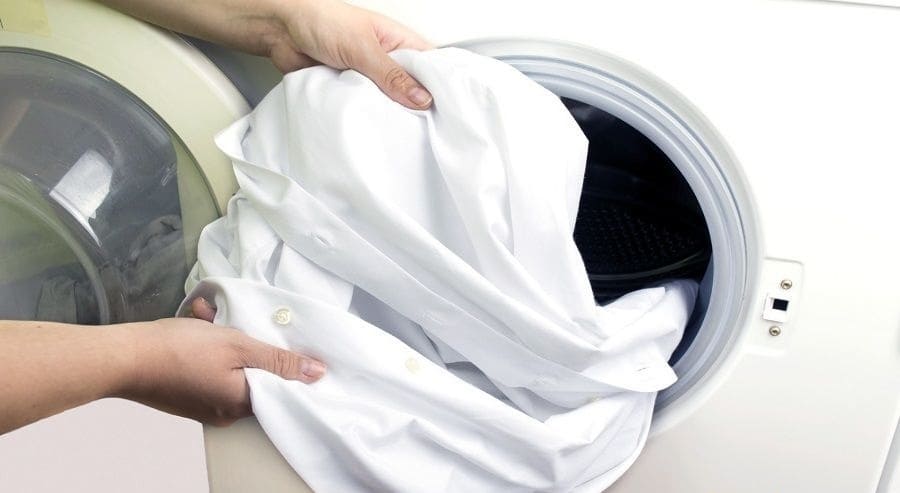
After thoroughly soaking, you can begin loading and turning on the washing machine. The water temperature must be selected depending on the material of the products. Cotton can most often be washed even at 90 degrees, although a water temperature of 60 degrees is recommended. Wool and silk are very gentle materials, and temperatures above 30 degrees are strictly contraindicated for them. More accurate information can be found on the tag sewn to the clothing.
Most often, regular washing powder will suffice, but it is useless if the initially white clothes begin to turn yellow.It is for such cases that bleach (as well as other products with a high chlorine content) was invented; yellowed items should be set aside separately and loaded into a drum using bleach.
No less close attention should be paid to the program in which your washing machine will operate. This information can also be found on the item's tag. If you are not completely sure about this, then you can select the mixed fabric washing mode. True, it is not present on all washing machines, and yours may not have it. The vast majority of washing machines have modes for cotton, synthetics, wool, children's clothing, and delicate materials. Some types of fabric can be combined and loaded into the drum, others will have to be washed separately.
It is strictly not recommended to use hard water for washing things; if everything is very bad with it, you need to use special water softeners. The most popular of these products is Colgon, but there are cheaper, but no less effective analogues. Hard water can not only cause damage to things, but also cause equipment breakdowns (including a washing machine).
Sometimes it is not possible to use the machine (it is broken or you simply have not purchased it yet), in such a situation you will have to wash the clothes manually. It is strictly not recommended to use “machine” (with the prefix “automatic”) powders; you need to use products specifically for hand washing. In addition to special chemicals, folk remedies will also help soften water; in particular, you can use ordinary table soda or some kind of lime.Installing a filter will also solve this problem (in the most expensive machines it is already installed, but it needs to be changed from time to time).
What powder should I use?
There is no definite answer to this question, we can only give some advice. First, use products from well-known brands, as their manufacturers carefully monitor quality. Secondly, it is not recommended to use powders for colored clothes; white clothes can be washed with their help very poorly and of poor quality. It is best to avoid the cheapest products; in addition to their poor properties in removing stains and dirt, they can harm particularly soft fabrics.
For light-colored wardrobe items, brands such as Tide, Aiel, AOS, BiMax and other well-known foreign manufacturers are recommended. Among the Russian powders we can mention Myth and Biolan; they also do a good job of washing light-colored fabrics.
What can I use besides washing powder?
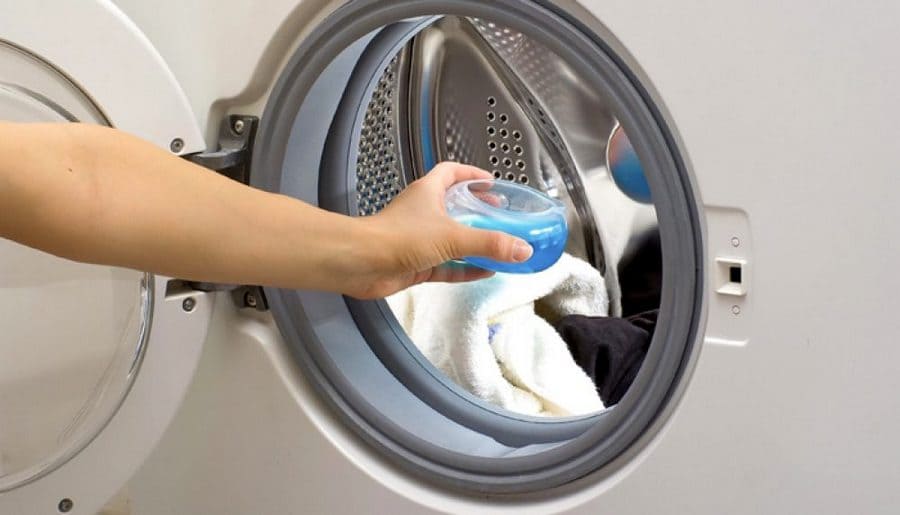
If desired, the standard powder can be replaced, especially if it is necessary to return the original whiteness to a yellowed wardrobe item. You can add a little boric acid to the water, make a solution of potassium permanganate with soap, and also resort to ammonia.
Boric acid is often used not only for bleaching, but also for disinfecting things. To do this, you will need to add literally a few tablespoons of acid to the washing machine (or other container) and soak for 30 minutes (do not overdo it, such chemical elements can have a bad effect on the structure of the fabric) .
A solution using permanganic acid and soap is one of the best ways to whiten things.To get rid of yellowness, grayness and stains, you need to thoroughly soap the item and place it in a bowl with dissolved potassium permanganate (approximately 2 tablespoons per 10 liters of water) for 3 hours. After this period, the item can be loaded into the washing machine.
The recipe with ammonia is the most complicated, since in addition to it you will need hydrogen peroxide, salt and regular table soda. It is necessary to mix peroxide with ammonia in a ratio of one to one, soda and salt are added as desired (they need three times more than the previous ingredients). It is necessary to soak everything in water for half an hour; it is not recommended to do this for too long.
How to dry white clothes correctly?
If White socks You can dry it almost any way you like, but other wardrobe items are more demanding when it comes to drying. The first step is to choose the right place for drying white clothes; well-ventilated sunny places, for example, a balcony, are more suitable for such purposes. But it is categorically not recommended to hang white fabric on the radiator; from such barbaric treatment it can turn yellow very quickly, and after that it will be incredibly difficult to bleach it.
Before direct drying, you must carefully check the cleanliness of the rope on which you will hang things, so as not to re-wash everything again. You should not hang crumpled linen and clothes; they must be carefully straightened. As soon as the clothes are dry, you need to take them off immediately; long exposure to the sun does not have a positive effect on almost any type of fabric.
Conclusion
Although washing clothes is not a particularly complicated process, it still requires a person to follow certain recommendations.This will not only increase the effectiveness of removing stains or dirt, but will also significantly extend the life of your white wardrobe items. Even colorless clothes should be washed and dried correctly so that you don’t have to go to the store for a new shirt, trousers or underwear.







